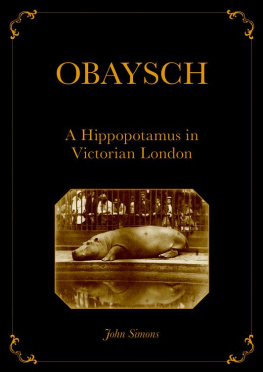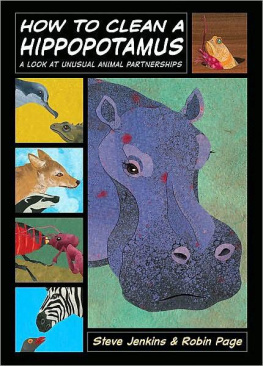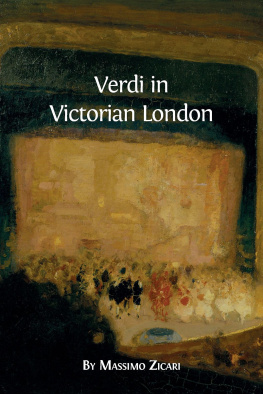Simons John - Obaysch: A Hippopotamus in Victorian London
Here you can read online Simons John - Obaysch: A Hippopotamus in Victorian London full text of the book (entire story) in english for free. Download pdf and epub, get meaning, cover and reviews about this ebook. year: 2019, publisher: Sydney University Press, genre: Art. Description of the work, (preface) as well as reviews are available. Best literature library LitArk.com created for fans of good reading and offers a wide selection of genres:
Romance novel
Science fiction
Adventure
Detective
Science
History
Home and family
Prose
Art
Politics
Computer
Non-fiction
Religion
Business
Children
Humor
Choose a favorite category and find really read worthwhile books. Enjoy immersion in the world of imagination, feel the emotions of the characters or learn something new for yourself, make an fascinating discovery.
- Book:Obaysch: A Hippopotamus in Victorian London
- Author:
- Publisher:Sydney University Press
- Genre:
- Year:2019
- Rating:4 / 5
- Favourites:Add to favourites
- Your mark:
- 80
- 1
- 2
- 3
- 4
- 5
Obaysch: A Hippopotamus in Victorian London: summary, description and annotation
We offer to read an annotation, description, summary or preface (depends on what the author of the book "Obaysch: A Hippopotamus in Victorian London" wrote himself). If you haven't found the necessary information about the book — write in the comments, we will try to find it.
Obaysch: A Hippopotamus in Victorian London — read online for free the complete book (whole text) full work
Below is the text of the book, divided by pages. System saving the place of the last page read, allows you to conveniently read the book "Obaysch: A Hippopotamus in Victorian London" online for free, without having to search again every time where you left off. Put a bookmark, and you can go to the page where you finished reading at any time.
Font size:
Interval:
Bookmark:
What is remarkable about Obaysch was that he was the first live hippopotamus (Hippopotamus amphibius) to be seen in England since Roman times. Indeed, he was the first live hippo to be seen in Europe.
There had once been plenty of hippos in Britain . During the second inter-glacial period, which ended about 125,000 years ago, they ranged across the island inhabiting an environment sustained by climactic conditions roughly equivalent to those of modern day Africa and enjoying co-existence with many other animals that we now think of as exclusively African. Perhaps less enjoyably as the size and strength of hippos make them more or less immune to predators once they reach maturity they co-existed with the humans who were also enjoying the warm climate and who retreated south, keeping ahead of the ice as it inexorably covered the savannahs of lowland Scotland and the tropical forests of Middlesex. Hippos make good eating and hippo bones are not uncommon finds. Stand in Trafalgar Square, for example, and you are standing where hippos once wallowed. Catch a train from Charing Cross and a few feet beneath the platform will be the remnants of a landscape that was once rich in hippos.
By Roman times things had warmed up again and pretty good red wine was being made from grapes grown in vineyards at Vinovia near Bishop Auckland in Englands now decidedly chilly north-east. It is only probable that hippos were imported into Roman Britain for gladiatorial displays. Certainly they were imported into Rome and the Emperor Commodus , a keen amateur gladiator, once killed five in a single session. In 1850 a note about Obaysch in the Glasgow Herald picked this up and made it the occasion for one of those how different, how very different, from the life of our own dear Queen comments that make the Victorian s so rewarding to study:
Commodus on one occasion exhibited five; and descending into the arena butchered some of these wretched beasts with his own hand. Queen Victoria , accompanied by her consort and their children, the hopes of Britain, can now graciously look upon the unmolested creature.
It is hard to comprehend the scale of the Roman games as far as animals were concerned. Thousands of creatures of every species were imported into Rome and marched through the streets to be slaughtered to liven up a holiday or reinforce a triumph. Nine thousand were killed in the games that inaugurated the Colosseum. There were certainly animal shows in Roman London, where the amphitheatre reproduced the pleasures of Rome on a provincial scale, but we do not know for sure whether or not hippos were ever floated down the Thames to titillate the crowds. The teenaged Emperor Gordian III had a huge menagerie that included at least three hippos, although there is some doubt as to whether this was for his amusement, like a private zoo, or a holding pen for a planned venatio, a public entertainment in which wild animals were released, hunted, and killed. The slightly mysterious Historia Augusta tells us that the wealthy usurper Firmus , who sounds very much like a real life Trimalchio, had a collection too and would take the great risk of riding on his hippo and his ostrich (which must have been a strong animal, as Firmus was a famously big man). It would be nice to think that instead of merely being kept for slaughter in the arena hippos might have been kept for decoration like the tamed lion with a gilded mane mentioned by Seneca or the 300 Mauretanian ostriches that Gordian I had dyed vermillion. I wonder if Lord Berners knew about that when he dyed his flock of doves? Probably he did.
There was other knowledge of hippos. Soldiers who had served in Egypt or were adepts of the cult of Isis may well have had an interest in Taweret, the hippo god . Certainly coins of the Empress Otacilia Severa stamped with the image of a hippo were circulating and have been found in at least one buried hoard in the British Isles. Did their original owners know what the image depicted, or did they just see yet another monster?
After the final surviving hippo breathed his or her last on the developing tundra or in the arena, Europe was not to see another live hippo until 1850 and the arrival of little Obaysch. There are a number of reasons for this. Firstly, hippos are very big and very fierce animals. They are, therefore, very hard indeed to catch alive. They live a long way from Europe and, in the absence of a unified state such as the Roman Empire, mounting an expedition to capture one would have required a very significant expenditure of money and people. And then, why would you want one? The royal and aristocratic menageries had not assumed the importance that they did later on and there were no public or private zoos. A king might like a lion or a few bears to reinforce his sense of status. The odd elephant or giraffe might be entertaining. A rhinoceros made a very rare visit. But the hippopotamus remained beyond the reach of desire and none were dragged across the Mediterranean to entertain the princes and popes (although there is an ambiguous report of one being shipped to Amsterdam in the early seventeenth century, possibly the one that, by 1697, was being exhibited stuffed at the University of Leiden).
In 1615 Rubens summoned up his very considerable imaginative forces and produced a significant painting depicting a hippopotamus and crocodile hunt for the Elector Maximilian I of Bavaria. This was part of a series of paintings of hunts the others were lion, bear and boar for the Schleissheim Palace. In the painting a hippo stands snarling in the middle of the composition with a crocodile below him, while Arabs on horse and foot and savage dogs swirl round it. The hippos head is garnished with fearsome teeth and forms the centre of a whorl of energy in which the chaos he represents is subdued by the forces of humanity and the animals it has trained for its own purposes. The image of the hippo is anatomically very accurate and almost certainly derives from Rubens viewing of two mounted hippo carcasses that had been brought to Italy in 1601 by the surgeon Federico Zerenghi , who dissected them and stuffed them. Whatever the physiological shortcomings of Zerenghis taxidermy , Rubens was able to imagine the animal in real life much as George Stubbs was able to do when he produced the first European painting of a kangaroo some 200 years later. His painting was the first time in many years that a hippo had found its way into European art, and also the last time for nearly 200 years that a reasonably accurate image of the animal would appear.
In addition, the Egypt ians themselves, who had in this pre-colonial period a tight monopoly on the hippos who lived much further down the Nile than they do now and were much more plentiful appear to have been quite reluctant to allow them to be interfered with. They had worked out a practical mode of living by which the natural antagonists, riparian Nile farmers and hippos, could co-exist and appear to have been quite protective of their unwieldy neighbours. Certainly there is at least one recorded episode from the early eighteenth century where locals in the vicinity of Rosetta drove off a French explorer who was attempting to capture a hippo.
Changing social and economic conditions and a much revised geopolitical map together with a new spirit of scientific discovery made it almost inevitable that by 1848 or 1849, when Obaysch was born and taught to graze happily with his mother on the banks of the Nile, the eyes of Europe would turn again to hippos and desire to see them alive. And now there were the new scientific zoological gardens to put them in. After the foundation of the first modern establishment, the Jardin des Plantes in Paris in 1792 (this was the date of the agreement to set up the institution but, arguably, the Jardin itself didnt properly exist until 1794), scientific and education al zoos were becoming an expected feature of the new cities of industrialised and industrialising Europe, the United States of America and Australia.
Font size:
Interval:
Bookmark:
Similar books «Obaysch: A Hippopotamus in Victorian London»
Look at similar books to Obaysch: A Hippopotamus in Victorian London. We have selected literature similar in name and meaning in the hope of providing readers with more options to find new, interesting, not yet read works.
Discussion, reviews of the book Obaysch: A Hippopotamus in Victorian London and just readers' own opinions. Leave your comments, write what you think about the work, its meaning or the main characters. Specify what exactly you liked and what you didn't like, and why you think so.










